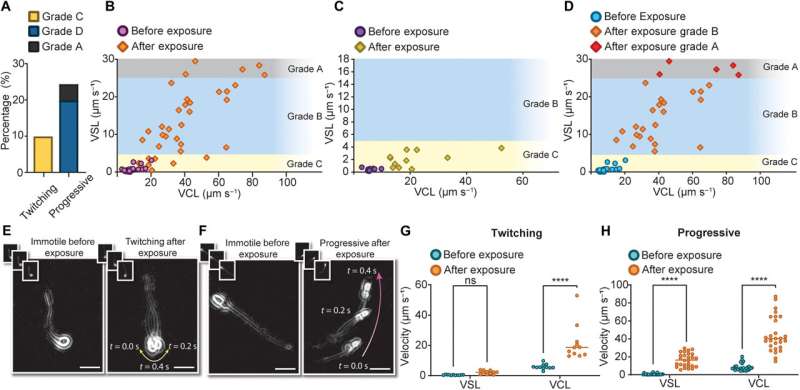February 15, 2024 report
This article has been reviewed according to Science X's editorial process and policies. Editors have highlighted the following attributes while ensuring the content's credibility:
fact-checked
peer-reviewed publication
trusted source
proofread
Application of ultrasound found to greatly speed up motility of human sperm

A team of engineers at Monash University in Australia has found that exposing human sperm to ultrasound can cause them to swim faster. In their study, published in the journal Science Advances, the group exposed human semen samples to ultrasonic waves and measured changes in sperm motility.
Prior research has shown that low sperm motility (or none at all) can lead to difficulties for males attempting to impregnate a female partner. To improve the odds, treatments including drugs have been used to speed up the sperm, but these also cause problems such as damage to sperm DNA.
To get around the problem, fertility doctors collect sperm from a donor and inject them directly into the uterus. In this new effort, the research team found a possible alternative—applying an ultrasound device to a woman's abdomen after intercourse to speed the sperm on their journey through the vagina and cervix and into the uterus.
Noting that prior research had shown that exposure to ultrasonic waves can impact sperm motility, the research team ran trials to determine if such reports were true, and if so, how much of an impact could be expected.
The researchers collected 50 semen samples from men with both normal sperm motility and motility problems, separating them into groups based on motility speed. The team isolated the sperm cells, and then exposed them to 800 milliwatts of ultrasonic waves for 20 seconds. Each of the samples was tested both before and after exposure.
The researchers found that exposing sperm to ultrasonic waves resulted in a dramatic increase in motility—the largest was a 266% increase. They also found that some sperm that were not motile at all could be jolted into swimming with a dose of ultrasound waves.
They theorize that the speed-up is due to the energy in the ultrasonic waves replacing deficits in sperm cell mitochondrial energy. They acknowledge that more work is required to ensure that ultrasonic waves do not damage the sperm cells or the reproductive cells in the female host, but suggest that the approach appears promising.
More information: Ali Vafaie et al, Making immotile sperm motile using high-frequency ultrasound, Science Advances (2024). DOI: 10.1126/sciadv.adk2864
Journal information: Science Advances
© 2024 Science X Network





















